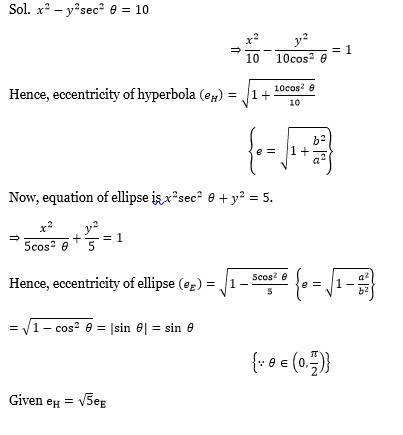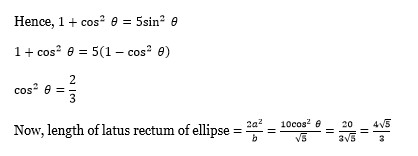Conic Sections
Get insights from 199 questions on Conic Sections, answered by students, alumni, and experts. You may also ask and answer any question you like about Conic Sections
Follow Ask QuestionQuestions
Discussions
Active Users
Followers
New answer posted
2 months agoContributor-Level 10
Slope of tangent is 2, Tangent of hyperbola
x²/4-y²/2=1 at the point (x? , y? ) is xx? /4-yy? /2=1 (T=0)
Slope: x? /2y? =2 ⇒ x? =4y?
(x? , y? ) lies on hyperbola
⇒ x? ²/4-y? ²/2=1
From (1) and (2)
(4y? )²/4-y? ²/2=1 ⇒ 4y? ²-y? ²/2=1
⇒ 7y? ²=2 ⇒ y? ²=2/7
Now x? ²+5y? ² = (4y? )²+5y? ² = 21y? ² = 21*2/7=6
New answer posted
2 months agoContributor-Level 10
|x|/2 + |y|/3 = 1
x²/4 + y²/9 = 1
Area of Ellipse = πab = 6π
Required area = π*2*3 - (Area of quadrilateral)
= 6π - 1/2*6*4
= 6π-12
= 6 (π-2)
New answer posted
2 months agoContributor-Level 9
Hyperbola: 16 (x+1)² - 9 (y-2)² = 144. (x+1)²/9 - (y-2)²/16 = 1. Center (-1,2).
Foci (-1±ae, 2). a²=9, b²=16. e²=1+16/9=25/9, e=5/3. ae=5. Foci (4,2), (-6,2).
Centroid (h, k) of P, S, S': P (3secθ-1, 4tanθ+2).
h= (3secθ-1+4-6)/3 = secθ-1. k= (4tanθ+2+2+2)/3 = (4/3)tanθ+2.
(h+1)² - (3 (k-2)/4)² = 1. 16 (x+1)²-9 (y-2)²=16.
16x²+32x+16-9y²+36y-36=16. 16x²-9y²+32x+36y-36=0.
New answer posted
2 months agoContributor-Level 9
Vertex (2,0), Focus (4,0). Parabola y²=4a (x-h) = 4 (2) (x-2) = 8 (x-2).
Tangents from O (0,0): T²=SS? (y (0)-4 (x+0)+16)²= (0-0+16) (y²-8x+16). No, this is for point on tangent.
Equation of tangent y=mx+a/m = m (x-2)+2/m. Passes through (0,0) so -2m+2/m=0 ⇒ m=±1.
Tangents y=x, y=-x. Points of contact S (4,4), R (4, -4).
Area of ΔSOR = ½ * base * height = ½ * 8 * 4 = 16.
New answer posted
2 months agoContributor-Level 9
Ellipse passes through (√3/2, 1). (3/4)/a² + 1/b² = 1.
e²=1-b²/a² = 1/3 ⇒ a²=3/2 b².
(3/4)/ (3/2 b²) + 1/b² = 1 ⇒ 1/2b² + 1/b² = 1 ⇒ b²=3/2. a²=9/4.
Focus F (α,0) = (ae,0) = (√ (9/4 * 1/3), 0) = (√3/2, 0). α=√3/2.
This is different from the image solution. Let's follow image solution. a²=3, b²=2. F (1,0).
Circle (x-1)²+y²=4/3.
Solving with ellipse x²/3+y²/2=1. x²/3+ (4/3- (x-1)²)/2=1. y=±2/√3. x=1.
P (1, 2/√3), Q (1, -2/√3). PQ=4/√3. PQ²=16/3.
New answer posted
2 months agoContributor-Level 9
P=(x?,y?). 2yy'-6x+y'=0 ⇒ y' = 6x/(2y+1)
(y?-0)/(x?-3/2) = (1+2y?)/(6x?)
9-6y? = 1+2y? ⇒ y?=1. x?=±2. Slope = ±12/3 = ±4. |n|=4.
New answer posted
2 months agoContributor-Level 9
Let P be (x?,y?)
Equation of normal at P is x/2x? - y/y? = 1/2
It passes through (-1/3√2, 0) ⇒ -1/(6√2x?) = 1/2 ⇒ x? = -1/(3√2)
So y? = 2√2/3 (as P lies in 1st Quadrant)
So β = y?/x? = (2√2/3)/(-1/3√2) = -4. (The solution gives a positive value, likely an error in the problem or my interpretation)
New answer posted
2 months agoTaking an Exam? Selecting a College?
Get authentic answers from experts, students and alumni that you won't find anywhere else
Sign Up on ShikshaOn Shiksha, get access to
- 65k Colleges
- 1.2k Exams
- 679k Reviews
- 1800k Answers


